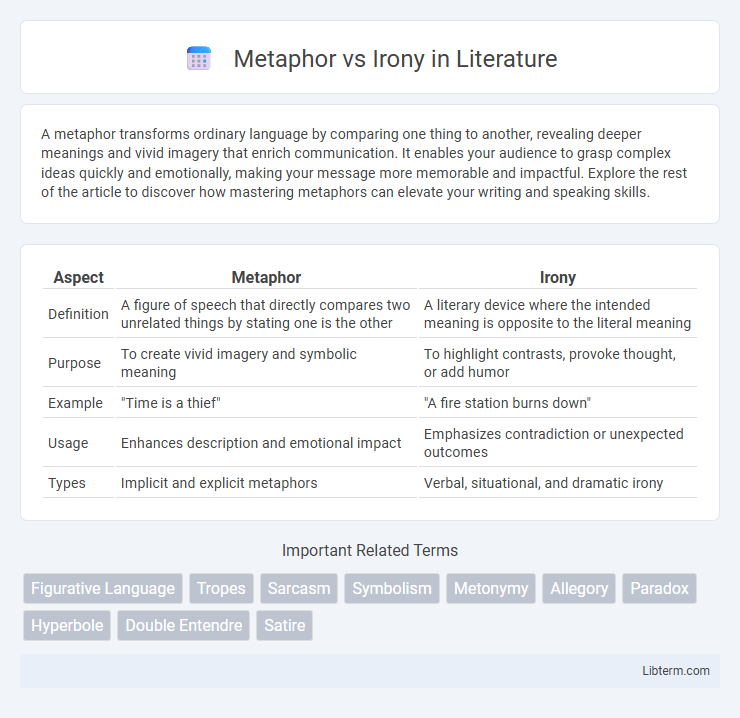A metaphor transforms ordinary language by comparing one thing to another, revealing deeper meanings and vivid imagery that enrich communication. It enables your audience to grasp complex ideas quickly and emotionally, making your message more memorable and impactful. Explore the rest of the article to discover how mastering metaphors can elevate your writing and speaking skills.
Table of Comparison
| Aspect | Metaphor | Irony |
|---|---|---|
| Definition | A figure of speech that directly compares two unrelated things by stating one is the other | A literary device where the intended meaning is opposite to the literal meaning |
| Purpose | To create vivid imagery and symbolic meaning | To highlight contrasts, provoke thought, or add humor |
| Example | "Time is a thief" | "A fire station burns down" |
| Usage | Enhances description and emotional impact | Emphasizes contradiction or unexpected outcomes |
| Types | Implicit and explicit metaphors | Verbal, situational, and dramatic irony |
Understanding Metaphor: Definition and Purpose
Metaphor is a figure of speech that directly compares two unrelated objects or concepts, revealing deeper meanings by highlighting similarities. Its primary purpose is to create vivid imagery and provoke thought, enabling readers to grasp complex ideas through familiar terms. Unlike literal language, metaphors enrich communication by adding layers of significance and emotional resonance.
What Is Irony? Key Concepts Explained
Irony is a literary device where the intended meaning differs from the literal meaning, often highlighting contradictions between appearance and reality. Key types include verbal irony, where speakers say the opposite of what they mean, situational irony, where outcomes defy expectations, and dramatic irony, where the audience knows critical information unknown to characters. This contrast creates tension, humor, or deeper insight, distinguishing irony from metaphor, which relies on symbolic comparison rather than contradiction.
Core Differences Between Metaphor and Irony
Metaphor involves describing one thing as if it were another to highlight similarities, creating vivid imagery and deeper understanding in language. Irony, in contrast, conveys a meaning opposite to the literal expression, often to emphasize disparity between expectations and reality. The core difference lies in metaphor's role in analogy and comparison, whereas irony focuses on contradiction and unexpected outcomes.
Types of Metaphors in Language and Literature
Metaphors in language and literature vary widely, including simple metaphors, complex metaphors, and mixed metaphors, each serving a unique function in conveying meaning beyond literal interpretation. Conceptual metaphors map one domain of experience onto another, shaping thought and communication, while visual metaphors use imagery to evoke comparisons. Understanding metaphor types enhances literary analysis by revealing layers of symbolism and thematic depth embedded in texts.
Exploring the Varieties of Irony
Irony encompasses various forms such as verbal irony, where a speaker says the opposite of what they mean, situational irony, involving an outcome contrary to expectations, and dramatic irony, where the audience knows crucial information unknown to characters. Each type manipulates meaning and perception to create contrast between appearance and reality, enhancing the depth of literary and rhetorical expression. Understanding these varieties of irony reveals how language can subtly convey critique, humor, or poignancy across contexts.
How Metaphors Shape Meaning in Communication
Metaphors shape meaning in communication by creating vivid connections between unrelated concepts, allowing abstract ideas to be understood through concrete imagery. They influence perception and interpretation by framing experiences in a familiar context, enriching emotional and cognitive responses. Unlike irony, which relies on contrast and contradiction, metaphors build meaning through symbolic association and imaginative insight.
The Role of Irony in Enhancing Expression
Irony enhances expression by conveying meanings that contrast with the literal interpretation, creating layers of depth and engaging the audience's critical thinking. Unlike metaphor, which draws direct comparisons to enrich imagery, irony relies on paradox and contradiction to highlight underlying truths or social critiques. This duality intensifies emotional impact and sharpens satire, making communication more nuanced and memorable.
Metaphor vs Irony: Common Misconceptions
Metaphor and irony are often confused due to their reliance on implied meanings, but metaphors explicitly compare two unrelated concepts to create symbolic connections, while irony highlights contradictions between expectations and reality. A common misconception is that both devices always convey sarcasm; however, metaphors primarily enhance understanding and imagery without necessarily implying mockery. Understanding their distinct functions improves clarity in literary analysis and communication.
Practical Examples: Metaphor and Irony in Everyday Use
Metaphors like "time is a thief" vividly illustrate abstract concepts by attributing human characteristics to time, making ideas more relatable in conversation. Irony appears in everyday remarks such as saying "What a beautiful view" when looking at a messy room, highlighting a contrast between expectation and reality. Both devices enrich communication by adding layers of meaning, with metaphors fostering imagination while irony often injects humor or criticism.
Choosing Between Metaphor and Irony for Effective Writing
Choosing between metaphor and irony depends on the desired impact on readers; metaphors create vivid imagery by comparing unrelated concepts, enhancing emotional connection and clarity, while irony conveys meaning through contrast between expectation and reality, often adding humor or critical insight. Effective writing leverages metaphors to simplify complex ideas and evoke sensory experiences, whereas irony can challenge perceptions and provoke deeper reflection. Writers should assess tone, purpose, and audience response to determine whether metaphor's imaginative expression or irony's layered meaning better serves their communicative goals.
Metaphor Infographic

 libterm.com
libterm.com